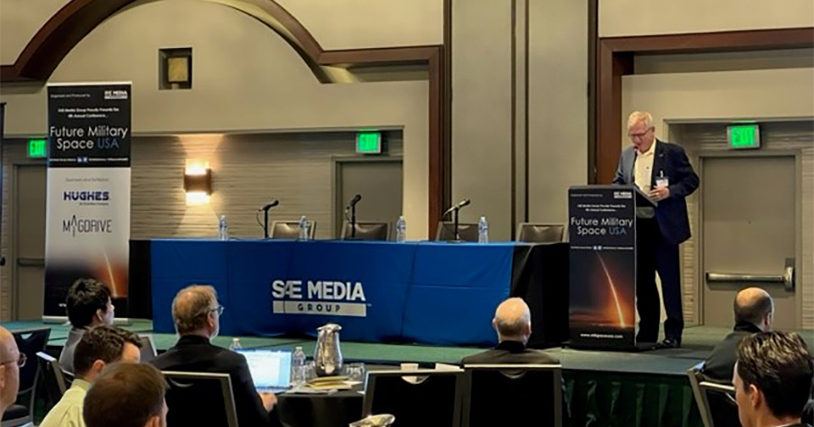
The 4th annual Future Military Space USA conference held earlier this month in Los Angeles, California, once again provided a unique forum for leaders from the U.S. and its allies to come together to discuss the future of military space. One underlying sentiment prevailed throughout the event: we must partner to develop a coalition Space Enterprise to counter any threat. As stressed by several speakers, including Dr. Stephen Pluntze, Executive Director of the Space Systems Command, partnerships between the U.S. and its allies are essential across every United States Space Force (USSF) mission to protect and defend the space environment.
As Dr. Michael Starks of the Air Force Research Laboratory (AFRL) explained, this “Allied by Design” strategy requires a hybrid and resilient approach to space and to space-based communications––a premise that I echoed in my presentation titled “LEO, MEO, GEO or all of the above?”
Here are five takeaways from the event:
- SATCOM is at a strategic inflection point. Low Earth Orbit (LEO) satellites are transforming what’s possible when it comes to satellite communications (SATCOM). Global low latency, high performance SATCOM service is now feasible from pole to pole, as evidenced by our deployment of a LEO network at Thule Air Base in Greenland. And LEO delivers the level of resilient, jam resistant communications that allied partnerships demand.
- GEO and MEO still have big roles to play. Geosynchronous Earth Orbit (GEO) and Medium Earth Orbit (MEO) satellites still have their place. While LEO satellites deliver high throughput at low latency, GEOs have the capacity to deliver lower cost, high throughput services with MEOs delivering significant capacity to support GPS, navigation and the exchange of space environment data.
- It’s not either/or…. It’s all three! The ideal DoD SATCOM “use case” is to explore all three – GEO, MEO and LEO -- options and to optimize choices based on cost, coverage, throughput and latency. Relying on all three ensures the greatest resiliency and guards against the limitations of “vendor lock,” or being obligated to a single service provider for an extended period of time.
- Technologies make it happen. While we’re getting closer to a “magic antenna” that can enable GEO, MEO and LEO, multiple terminal technologies can enable seamless switching among multiple constellations, like MEO/GEO and LEO/GEO pairings. For example, the Hughes Electronically Steerable Antenna (ESA) is an innovative, low-cost, flat panel antenna technology that is proving to be a game-changer for LEO implementations. The ESA––with its low profile, sleek design––delivers high throughput and low latency connectivity; and can support fixed, land mobile, maritime, and aviation applications, offering connectivity options that were simply unavailable to defense agencies until now.
- EM&C Policy Control and Software Defined WAN are vital to managing diverse network orchestration. Enterprise Management and Control (EM&C) determines when, why and how the system should access diverse SATCOM resources based on situational awareness. SD-WAN routes packets over different paths (LEO, GEO, terrestrial and LTE included) in real-time. Hughes is leading the industry in the use of SD-WAN across constellations and transports. Together, EM&C and SD-WAN enable the network to automate and optimize choices based on coverage, throughput and latency–driving increased performance, diversity and resiliency.
These capabilities are proven and scalable, having been demonstrated to the U.S. Department of Defense across multiple funded projects. Additionally, leveraging commercial technologies and DevSecOps leads to rapid development of custom government EM&C––all of which means multi-orbit, multi-constellation, resilient and secure networks stand ready to connect Allied by Design partners.